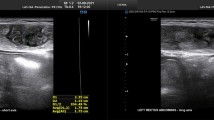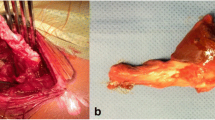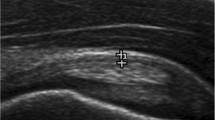Abstract
Objective
To assess rectus abdominis (RA) thickness and injury prevalence using ultrasound in a group of professional tennis players. Observations with regard to muscle fiber repair is described. We likewise studied the potential link between RA volume asymmetry and the risk of muscle strain.
Materials and methods
The degree of asymmetry between the different RA slices was assessed using ultrasound in 61 professional tennis players. The history of RA injury in these tennis players was likewise studied, taking into account the following factors: dominant vs non-dominant arm, history of RA strains, duration thereof and number of recurrences. Ultrasound examination was performed with an 8- to 12-MHz linear multi-frequency transducer.
Results
Ultrasound revealed the presence of fibrous scar tissue in the RA muscle in 18 cases (29.5%). In all instances, the lesion was located in the RA on the side of the nondominant arm. In 16 of the cases, the lesion was infra-umbilical and L2 was affected in two cases. The mean maximum width of the fibrous repair tissue was 9 mm (range 5–16). The mean distance between the umbilicus and the scar was 5.8 cm (range 2.9–11.4). Statistical study of the ultrasound measurements obtained for the different slices revealed statistically significant differences between the different depths and according to arm dominance.
Conclusions
In the series studied, the prevalence of RA muscle lesion in professional tennis players was 29.5%. Asymmetric hypertrophy of the RA muscle appears to constitute a risk factor for suffering an injury in this location.





Similar content being viewed by others
References
Connell D, Ali K, Javid M, Bell P, Batt M, Kemp S. Sonography and MRI of rectus abdominis muscle strain in elite tennis players. AJR Am J Roentgenol. 2006;187:1457–61.
Calbet JA, Moysi JS, Dorado C, Rodriguez LP. Bone mineral content and density in professional tennis players. Calcif Tissue Int. 1998;62:491–6.
Sanchis-Moysi J, Dorado C, Olmedillas H, Serrano-Sanchez JA, Calbet JA. Bone and lean mass inter-arm asymmetries in young male tennis players depend on training frequency. Eur J Appl Physiol. 2010;110:83–90.
Sanchis-Moysi J, Dorado C, Olmedillas H, Serrano-Sanchez JA, Calbet JA. Bone mass in prepubertal tennis players. Int J Sports Med. 2010;31:416–20.
Sanchis-Moysi J, Idoate F, Dorado C, Alayón S, Calbet JAL. Large asymmetric hypertrophy of rectus abdominis muscle in professional tennis players. Plos One. 2010;5:1–8.
Sanchis-Moysi J, Idoate F, Olmedillas H, Guadalupe-Grau A, Alayon S, et al. The upper extremity of the professional tennis player: muscle volumes, fiber-type distribution and muscle strength. Scand J Med Sci Sports. 2010;20:524–34.
Kanehisa H, Ikegawa S, Fukunaga T. Comparison of muscle cross-sectional area and strength between untrained women and men. Eur J Appl Physiol Occup Physiol. 1994;68:148–54.
Perez-Gomez J, Rodriguez GV, Ara I, Olmedillas H, Chavarren J, et al. Role of muscle mass on sprint performance: gender differences? Eur J Appl Physiol. 2008;102:685–94.
Garrett Jr WE. Muscle strain injuries. Am J Sports Med. 1996;24(6):2–8.
Balius R, Pedret C, Pacheco L, Gutierrez J, Vives J, Escoda J. Rectus abdominis muscle injuries in elite handball players: management and rehabilitation. Open Access J Sports Med. 2011;2:69–73.
Maquirriain J, Ghisi JP, Kokalj AM. Rectus abdominis muscle strains in tennis players. Br J Sports Med. 2007;41:842–8.
Rob J. Abdominal wall injuries: rectus abdominis strains, oblique strains, rectus sheath hematoma. Curr Sports Med Rep. 2006;5:99–103.
Aagaard H, Jorgensen U. Injuries in elite volleyball. Scand J Med Sci Sports. 1996;6:228–32.
Curran-Everett D. Multiple comparisons: philosophies and illustrations. Am J Physiol Regul Integr Comp Physiol. 2000;279:1–8.
Middleton W, Teefey S, Yamaguchi K. Sonography of the rotator cuff: analysis of interobserver variability. AJR Am J Roentgenol. 2004;183:1465–8.
Balduini FC. Abdominal and groin injuries in tennis. Clin Sports Med. 1988;7:5–9.
Lehman RC. Thoracoabdominal musculoskeletal injuries in racquet sports. Clin Sports Med. 1988;7:267–76.
Kibler W, Chandler J. Racquet sports. In: Fu FH, Stone DA, editors. Sports injuries—mechanism, prevention, and treatment. Baltimore: Williams & Wilkins; 1994. p. 278–92.
Gutierrez D, Esparza F. Lesiones en el tenis. Revisión bibliográfica. Apunts Med Esport. 2011. doi:10.1016/j.apunts.2011.07.004doi: 10.1016/j.apunts.2011.07.004
Mannion A, Pulkovski N, Toma V, et al. Abdominal muscle size and symmetry at rest and during abdominal hollowing exercises in healthy control subjects. J Anat. 2008;213:173–82.
Rankin G, Stokes M, Newham D. Abdominal muscle size and symmetry in normal subjects. Muscle Nerve. 2006;34:320–6.
Macgillivray TJ, Ross E, Simpson HAHRW, Greig CA. 3D freehand ultrasound for in vivo determination of human skeletal muscle volume. Ultrasound Med Biol doi:10.1016/j.ultrasmedbio.2008.11.013
Acknowledgements
We would like to thank the Spanish Royal Tennis Federation and the group of international tennis players who, despite being in the middle of a competition, took the time to participate in this study. We would also like to thank Dr Asun Estruch (1954–2010), who looked after the Spanish group for many years and lent a helping hand "on court" at the beginning of this study.
Competing interests
None.
Ethics approval
Ethics approval was obtained from the Consell Català de l’Esport.
Author information
Authors and Affiliations
Corresponding author
Rights and permissions
About this article
Cite this article
Balius, R., Pedret, C., Galilea, P. et al. Ultrasound assessment of asymmetric hypertrophy of the rectus abdominis muscle and prevalence of associated injury in professional tennis players. Skeletal Radiol 41, 1575–1581 (2012). https://doi.org/10.1007/s00256-012-1429-y
Received:
Revised:
Accepted:
Published:
Issue Date:
DOI: https://doi.org/10.1007/s00256-012-1429-y




